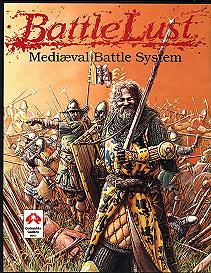
BattleLust

Back to FANTASY SKIRMISH RULES
Back to MEDIEVAL RULES
| J. Murphy (jmurphy@shentel.net) |
|---|
I have played BattleLust a few times, and it is the best I have played. I think it feels very "realistic." It works best with small skirmishes (~20-50/side), but if you have a full evening you can play large skirmishes like ~100 men per side and have a very good time doing it. Did this at one of the cons a couple years back and had a blast. The ability to use HarnMaster combat (the old version anyway) for player-character combat makes a colorful addition in a skirmish game (e.g. your personal commander's combat can be resolved with a greater attention to detail). I would rate it much better than Retinue (which would, however, be my second favorite among those I have played). Retinue is much more convoluted in terms of table look-ups, but a little quicker in the mechanics of how many die rolls. Also, play alternates by side rather than by small unit as in BattleLust. It ends up, therefore, being similar in terms of handleable scale. I think BattleLust feels better to play for a variety of reasons, but mainly because the mechanics seem to me to correspond to what is happening, whereas Retinue is less intuitive and more results-oriented. Retinue is more of a early WRG style game with the multiple look-up charts, only in the case of a skirmish game it results in mechanics that do not feel right to me. |
| Charles Thumann (thumann@netcom.com) |
Ok, I've only played it once with a very small skirmish-level battle. And I don't even own the rules (I haven't been able to find it). But I am very impressed by it. I had pretty much given up on any sort middle-ages gaming but this game has definately "bit" me. The rules seem realistic, leave a lot of room for creativity, and are pretty simple to use. It's hooked me enough to want to go buy the rules and a whole bunch of medieval miniatures to go with them. If you live in Southern California, maybe we could get together for a game. E-mail me. |
| Jim Stuht (stuht@macc.wisc.edu) |
I use BattleLust for my Viking games and it works quite nicely. It looks like the game started out as an individual fig type game and they layered on the unit and command portions, but they did a creditable job of it. While the charts and individual fig sheets look daunting at first glance, I've found that by the 3rd turn or sooner, even novice players pick up the rules and the game can pretty much run itself. The most time-consuming thing about the game is generating the stat cards for your specific figs. Thankfully this need only be done once, then you are set. If you set up a computer program to generate the cards, when you need more, it's a breeze to get more. |
| Procopius (procopius@mail.utexas.edu) |
There are a few things I wanted to point out.
This is a condensed version of Procopius' criticisms of BattleLust. An expanded version can also be viewed. |
| Add review? |